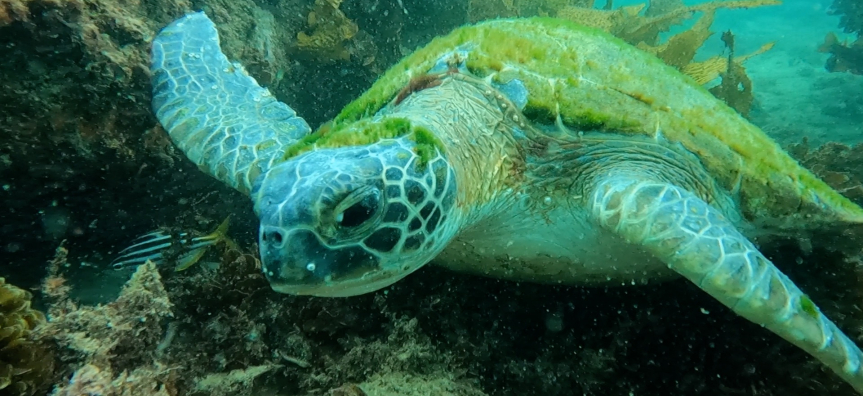
Learn about the local Green Sea Turtles at Cabbage Tree bay.
TRANSCRIPT:
(Sian is sitting on the rocks overlooking Cabbage Tree Bay. She describes green sea turtles in the Bay. The video contains overlay shots of green sea turtles and Sian snorkelling underwater in the bay.)
Sian Liddy:
The juvenile green sea turtles that we have here in Cabbage Tree Bay will spend around ten years of their life using the bay as a foraging ground. It’s a beautiful, shallow water habitat full of seagrass and algae and other invertebrates that they might like to eat.
You might see them with a lot of algae growing on their shells. They also have other organisms that hitch a ride like barnacles, arthropods, and a few other invertebrates as well.
We can’t actually determine whether a sea turtle is in good or poor health just from looking at the presence of barnacles on their shells. This can be a completely normal part of their biology and sea turtles are often found scraping their shells against rocks to keep their shells nice and clean.
Despite spending all of their lives in the ocean, sea turtles are reptiles and they do need to breathe air, so you’ll see them coming up to the surface to take a breath. On average, their breath hold can last around 20 minutes but when they are resting you might find them diving a little bit deeper, their heartrates slow so dives can then reach a few hours.
Now it does take about 30-40 years for green sea turtles to reach sexual maturity. They do return not to the exact beach that they were born but to that general region.
After the mother turtles lay their eggs, they’ll spend around two months incubating in the sand, so the sand temperature actually influences the sex of the hatchlings. Below 26 degrees Celsius, you’ll get predominately males, above 29 degrees Celsius you’ll get predominately females, and in the middle there you’ll have a nice mix.
Because of the complex life history of these amazing animals from when they’re sitting in the sand as eggs to when they’re hatchlings running down the beach, juveniles right here in our backyard, to adults migrating incredibly large distances.
Everyone can do their part to protect sea turtles and help in their conservation by picking up plastic when you’re in the water or when you see it washed up on the beach.
